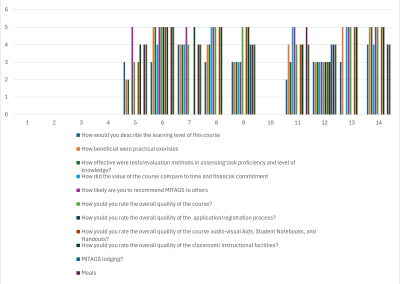GWO Basic Safety Training
Similar in methodology to Standards of Training, Certification and Watchkeeping for Seafarers (STCW), the MITAGS Global Wind Organisation-approved (GWO) Basic Safety Training (BST) program focuses on best safety practices relevant to the service and installation of wind turbines. With in-depth perspectives on maritime safety standards and hazards, MITAGS is a leader in innovative solutions that are practical and efficient for offshore GWO training.
GWO BST provides instruction and practical exercises in relevant safety skills necessary to work in a variety of different roles with designated duties on Wind Energy job sites. Courses include:
- Fire Awareness
The knowledge and skills necessary to prevent and handle fires in the wind turbine tower and nacelle. Training incorporates fire prevention, the correct use of fire extinguishers, and evacuation procedures. Participants learn to recognize and respond to different types of fires, and to safely evacuate the tower in the event of an emergency. - First Aid
Best practice in response to accidents in and around the wind turbine platform, with exercises to prepare participants to treat injuries such as cuts, burns, and fractures. Trainees learn to perform CPR, use a defibrillator, and contact emergency services. - Manual Handling
Training incorporates safe lifting and maneuvering techniques for workers in unique and challenging environments. Instruction includes the safe use of cranes and hoists with correct ergonomic procedures to prevent injuries related to lifting moving parts and equipment. - Sea Survival
Coursework imparts skills necessary to survive at sea in the event of an emergency. Participants practice rescue procedures with the use of life jackets and rafts. Instruction prepares trainees to safely embark upon and disembark offshore wind turbine platforms. - Working At Heights
Exercises demonstrate best practices to safely climb the turbine tower and work at high elevations. Training covers risk assessment, fall protection equipment, and rescue techniques. Participants are trained to use the correct safety equipment and to perform a rescue in the event of an emergency.
MITAGS offers GWO Basic Safety Training courses coast to coast to meet the needs of the GWO workforce.
- East Coast Campus: Linthicum Heights, Maryland
- West Coast Campus: Seattle, Washington
Please note:
Students in these programs will be required to participate in rigorous physical activity which will include, but is not limited to, the following:
- Wearing and working with a full body harness in suspension.
- Repeatedly climbing a ladder up to 24 vertical feet for an entire day.
- Performing suspended rescues on mannequins and live persons at heights.
- Jumping into pool from height of approximately one meter.
- Swimming a distance of approximately 20 feet while wearing a PFD or immersion suit.
- Staying afloat for approximately 1 minute without the use of a PFD or similar aid.
- Deploying and entering a life raft and righting a capsized life raft while wearing a PFD or immersion suit.
- Conducting search & rescue of simulated personnel casualties weighing approximately 150 pounds from an enclosed smoke and fire environment, while wearing breathing apparatus and protective clothing.
- Extinguishing fires with and without the aid of breathing apparatus. This will include moving quickly and climbing up and down ladders while holding fire fighting equipment such as heavy hoses.
- Bending, stooping, lifting, and turning real or simulated patients.
- Performing cardio-pulmonary resuscitation on a mannequin.
ENHANCEMENTS & UPGRADES
- Dynamic Positioning
- Water Jet Simulation
- Virtual Reality
- Remote Cloud Simulation
- Six new Azipod simulators
(for a total of 11) - Six new water jet simulators
- Six new virtual reality and mixed reality simulator stations
- Virtual reality simulation collaboration with the full mission ship simulator
- Installation of new dynamic positioning lab to support DP1 & DP2 with upcoming Nautical Institute Dynamic Positioning Accreditation
- Motion chair simulation capabilities
- 16 ECDIS/RADAR/ARPA lab upgrades
- 12-student capacity
- Pilot Ladder Safety Training
- Rafts
- Immersion suits
- Personal floatation devices
- Medical mannequins
- Fire suppression training tools

